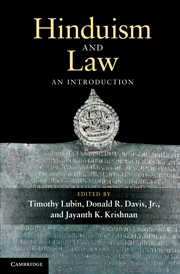Book contents
- Frontmatter
- Contents
- List of contributors
- Acknowledgements
- Chronology
- Abbreviations
- Map South Asia: political divisions c. 1860 and today
- Introduction
- Part I Hindu law
- Part II Law in ancient and medieval Hindu traditions
- Chapter 7 Hindu jurisprudence and scriptural hermeneutics
- Chapter 8 Indic conceptions of authority
- Chapter 9 Śūdradharma and legal treatments of caste
- Chapter 10 Law, literature, and the problem of politics in medieval India
- Chapter 11 Hindu law as performance
- Part III Law and modern Hinduism
- Glossary
- Bibliography
- Index
Chapter 11 - Hindu law as performance
ritual and poetic elements in Dharmaśāstra
Published online by Cambridge University Press: 05 June 2012
- Frontmatter
- Contents
- List of contributors
- Acknowledgements
- Chronology
- Abbreviations
- Map South Asia: political divisions c. 1860 and today
- Introduction
- Part I Hindu law
- Part II Law in ancient and medieval Hindu traditions
- Chapter 7 Hindu jurisprudence and scriptural hermeneutics
- Chapter 8 Indic conceptions of authority
- Chapter 9 Śūdradharma and legal treatments of caste
- Chapter 10 Law, literature, and the problem of politics in medieval India
- Chapter 11 Hindu law as performance
- Part III Law and modern Hinduism
- Glossary
- Bibliography
- Index
Summary
Every system of law is, at the same time, a semiotics: a set of rhetorical techniques designed to communicate the law’s commands, persuade that these commands are just, and impress them on the popular memory. Although this is as true of modern law as it is of ancient, the semiotics of some older legal systems such as Hindu Dharmaśāstra is markedly different from that of our contemporary legal system. Dharmaśāstra deploys numerous rituals and poetic and other literary devices in both its textual structures and its depictions of legal practice. Examples are oaths, trials by ordeal, penances, and symbolic punishments that resemble and coordinate with the operations of the cosmic law of karma. Such devices have inspired the classification of Dharmaśāstra as “primitive” or “religious” law, a characterization that, although not entirely inaccurate, serves mainly to defer explanation.
The present chapter attempts to account for some of these curious features of Dharmaśāstra by describing their semiotic function. In doing so, it borrows from the growing field of legal semiotics which, sometimes under the rubric of “law and literature,” in recent decades has made significant progress in illuminating the symbolic, narrative, and rhetorical dimensions of both modern and ancient legal systems (compare D. R. Davis 2007). This approach to Dharmaśāstra is informed in particular by recent semiotic analyses of ancient Jewish law (Douglas 1999; Jackson 2002a, 2006; Sawyer and Douglas 1996). There are significant parallels between these two ancient legal systems, particularly in terms of their semiotic properties. As in the case of Jewish law, some of the more distinctive features of Dharmaśāstra may best be understood in terms of their contribution to rhetorical performance: as aesthetic and communicative activity, rather than merely a set of substantive rules or a “code” in the modern sense. “Performance” denotes the entire range of communicative and expressive functions served by cultural forms, including “intersubjective communication, cultural transmission, social influence, and rhetorical persuasion” (Yelle 2006: 379; compare Bell 1998; Tambiah 1985). An analysis of performance attends to the work done or effects achieved by ritual and other expressive forms of behavior in situated social contexts, and emphasizes the pragmatic dimensions of such behaviors rather than merely their semantic contents. Such an approach holds significant promise for the interpretation of the symbolic and ritual dimensions of legal systems such as Dharmaśāstra and, as we shall see, represents an advance over earlier views that either dismissed these rituals as superstitious nonsense or attempted to account for them in naturalistic terms.
- Type
- Chapter
- Information
- Hinduism and LawAn Introduction, pp. 183 - 192Publisher: Cambridge University PressPrint publication year: 2010
- 2
- Cited by

